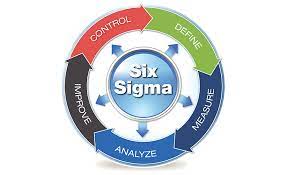Six Sigma is a set of techniques and tools for process improvement. It was introduced by American engineer Bill Smith while working at Motorola in 1986. A six sigma process is one in which 99.99966% of all opportunities to produce some feature of a part are statistically expected to be free of defects.
This strategies seek to improve manufacturing quality by identifying and removing the causes of defects and minimizing variability in manufacturing and business processes. It does this by using empirical and statistical quality management methods and by hiring people who serve as this experts. Each Sigma project follows a defined methodology and has specific value targets, such as reducing pollution or increasing customer satisfaction.
The term Six Sigma originates from statistical modeling of manufacturing processes. The maturity of a manufacturing process can be described by a sigma rating indicating its yield or the percentage of defect-free products it creates—specifically, to within how many standard deviations of a normal distribution the fraction of defect-free outcomes corresponds.
This term comes from statistics, specifically from the field of statistical quality control, which evaluates process capability. Originally, it referred to the ability of manufacturing processes to produce a very high proportion of output within specification.
Processes that operate with “quality” over the short term are assumed to produce long-term defect levels below 3.4 defects per million opportunities (DPMO). The 3.4 dpmo is based on a “shift” of ± 1.5 sigma explained by Mikel Harry. This figure is based on the tolerance in the height of a stack of discs.
Why it is important?
One of the reasons why implementation is important is that it helps in reducing defects. Using this techniques, employees are able to identify problem areas as well as recurring issues that affect the overall quality expectation of a service or product from a customer’s viewpoint.
What are advantages of six sigma?
- You will decrease waste.
- You will increase efficiency.
- It reduce errors.
- This reduces your company’s legal risk.
- You can apply it to any industry.
- You will make more money.
What are disadvantages of six sigma?
Because this is apply to all aspects of the production and planning process, it may create rigidity and bureaucracy that can create delays and stifle creativity. Process improvement and product improvement are the direct benefits of incorporating it. This leads to a reduction in defects and improves customer satisfaction.
Why does Six Sigma fail?
Almost invariably, the failure of any Lean this project can be traced to a scope that was too broad. Trying to minimize variation in an entire product, for example, is so defocus that little improvement can happen in any part of the product. Always error on the side of scoping your projects too small.
What is the failure rate in Six Sigma?
“Six Sigma” measures the capability of a process to perform defect-free work. It means a failure rate of 3.4 parts per million or 99.9997% perfect; however, the term in practice is use to denote more than simply counting defects.
How effective is Six Sigma?
The standard for a organization is to create processes that result in no more than 3.4 defects per million opportunities (DPMO). That translates into 99.99966% of all opportunities being free of any defect.
Why is Six Sigma better than TQM?
The basic difference between Six Sigma and TQM is the approach. While TQM views quality as conformance to internal requirements, Six Sigma focuses on improving quality by reducing the number of defects. The end result may be the same in both the concepts (i.e. producing better quality products).
Why is it difficult to implement Six Sigma in clinical settings?
According to the results, the biggest barrier related to not using this is based on the lack of knowledge about Six Sigma. The other important barrier about the diffusion of Sigma within this organizations is related to the lack of support from top management and leaders.
How long does it take to get Six Sigma?
The Sigma Black Belt certification generally takes between 1 to 3 months to study for and complete, depending on the organization you get your certification through. The average completion time for this Black Belt through the Management and Strategy Institute is 30 days.





